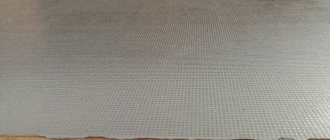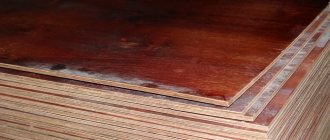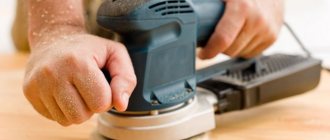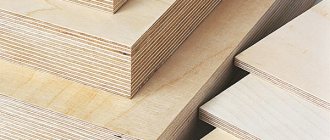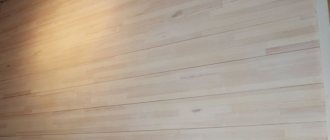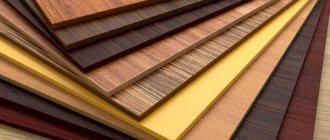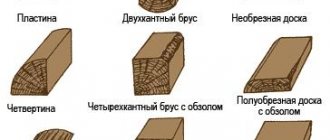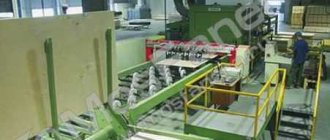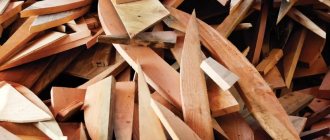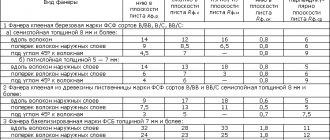Bakelite plywood is also called bakelite or marine plywood. Durable material has a multi-layer structure. The main raw material for its production is birch wood. The layers or veneer of this tree are firmly bonded together with resins and subsequent heat treatment. Marine plywood is distinguished by such properties as reliability, high strength and wear resistance.
Bakelite plywood acquires special properties as a result of treatment with bakelite varnish, from which it gets its name. Marine plywood can withstand temperatures from +50 to -50 degrees, while it is not susceptible to mold or mildew. It can also be used even in tropical climates with high humidity levels. Moreover, its useful life is 15 years or more. This type of plywood will be described in detail below. The article talks in detail about the material and its areas of application, adds a couple of useful videos on the topic, and also offers the reader interesting material for downloading.
What is bakelite plywood?
What is bakelite plywood?
This material is usually classified as universal, since its scope of use is not limited only to construction work.
Such plywood has several common names - “aviation”, “Finnish”, “ship” or “deck”, “delta wood”. The characteristics of this variety are close to those of low-alloy steel. Such qualities are achieved through a special manufacturing technology, which includes impregnation with special alcohol- and water-soluble resins. The resulting coating is hard and visually resembles plastic or carbolite products.
Bakelized boards (FB) are made on the basis of birch veneer, like other brands of plywood, but have the best performance properties.
The combination of peeled birch veneer with bakelite varnishes and resins produces a material with the highest performance characteristics
Material Features:
- Water resistance. The exception is options made using water-based glue.
- Immune to the influence of microorganisms. The treatment completely eliminates the threat of mold, mildew and insects.
- Wear resistance. Combined with high strength, the resulting skin is able to withstand constant severe mechanical stress and withstand sudden temperature fluctuations in the range from -50 to +50 degrees.
Such parameters allow long-term use of products in various aggressive conditions without loss of properties.
On a note! Due to the high price, slabs are rarely found in stores and are mainly delivered to order.
Types of plywood
There are seven main types of plywood:
- FK plywood is a moisture-resistant type; urea resin is used for gluing veneer sheets. This plywood is intended for indoor use.
- FKM plywood – has increased water resistance and is made on the basis of melamine resins. This type of plywood is unique, since environmentally friendly melamine resins are used for its production. Due to its environmental characteristics, plywood is used in furniture production. In addition, FKM plywood is used for interior finishing work.
- FSF plywood - veneer sheets are glued together using phenolic resin. This type of plywood also has increased water resistance. Typically used for exterior finishing work.
- Laminated plywood is based on FSF plywood, which is covered on both sides with a special film. Laminated plywood is used for the manufacture of formwork. This type can be used repeatedly.
- Bakelized plywood – bakelite resin is used to glue veneer sheets together. This type of plywood is used in aggressive climates, sea water, aggressive environments, and sometimes for monolithic work.
- Marine plywood is similar to bakelized plywood, but less durable. Made from foreign wood species.
- Flexible plywood is a foreign option. A distinctive feature is the ability to bend well in the transverse and longitudinal directions.
READ What is laminated chipboard and where is this material used?
Depending on the type of mechanical surface treatment, plywood can be of three types: unsanded, sanded on both sides or one side.
Use for formwork.
Plywood is a product made from various types of wood. It could be: birch, aspen, pine needles, poplar. Combined plywood is called plywood, which includes several types of wood material.
Question to the expert
What material is bakelite plywood made from?
Birch plywood is a very durable type. This is determined by the high physical and chemical properties of birch plus a multilayer structure. Coniferous plywood is made from pine, which provides strength at a relatively low weight. This type is successfully used in the construction of houses. The quality of plywood depends on a number of indicators.
The main one is the emission class of free formaldehyde (E1-E2). The quality of the product is also ensured by such indicators as: tensile strength when chipping, tensile strength of samples, static bending, structure, color of knots, presence of defects, moisture content. The grade of plywood is determined by the number of knots per 1 square meter. Plywood can be of four grades.
Construction and bakelite plywood
The most popular type is construction plywood sheets, which are made from pine and larch. The thickness of such a plate is 2-4 mm. There are combined options, for the production of which two different types of wood are used. Products based on the use of coniferous veneer are divided into 6 types. They are used for both external and internal construction work.
Interesting read: balsam fir wood.
Combined plywood is available in a wide range. The length of such sheets can be almost 2.5 m, the width can be 1.20 m. The thickness of plywood sheets ranges from 0.8 to 3 cm. There is also plywood, for the production of which alder is used. This representative of coniferous forests is used much less frequently, but is of higher quality.
Moisture-resistant, durable bakelite plywood.
Bakelite plywood consists of birch veneer and phenol-formaldehyde resin is used as impregnation. The outer layer of such a product can be impregnated with an alcohol-soluble composition. This type of plywood is characterized by high strength and can withstand heavy loads, so its use is not limited only to interior work, it is used in shipbuilding, construction, aircraft manufacturing, etc. the thickness of such a product is 0.5-1.8 cm, length 7.70-1 .5 m, width – 1.55-1.2 m.
Plywood for cladding has peeled veneer in its structure. In this case, one side or both have a polished surface, which makes it possible to use it for finishing work. The glue can be based on phenol-formaldehyde or urea-formaldehyde. Cladding plywood is available in two grades.
For interior and exterior wall decoration, bakelite plywood is attached to pre-plastered concrete bases using various mastics, for example, definol. To ensure longer service life of plywood sheets, they are coated with special varnishes or waterproof impregnations. Before starting this procedure, all existing joints are covered with thin beams, and uneven areas and cracks are primed. This type of treatment helps protect the wood product, as well as the walls underneath it.
FAQ
What temperatures can bakelite plywood withstand?
Can be used at temperatures from -50 to +50 degrees.
What is the service life of bakelite plywood?
Service life is up to 15 years.
Which bakelite plywood is considered defective?
Bakelite plywood with uncoated and unimpregnated areas, bubbles, under-pressing, and delamination is considered defective.
Production of material
The production of plywood is carried out taking into account the requirements of GOST 11539-83.
Description of technology:
- Birch logs arrive at the plant. At the preliminary stage, the raw materials are cleaned of bark and knots, after which they are sawn to the required size.
- The resulting fragments are well soaked and supplied to wood peeling equipment.
Scheme for obtaining peeled veneer - The veneer layers are moved to a line where glue is applied. Water- or alcohol-soluble cresol-formaldehyde or phenol-formaldehyde resins are used for work.
- The veneer finishing process varies depending on the brand being manufactured. To achieve the desired characteristics, the wood section can be impregnated with the selected composition or coated. The structure of the resulting slab consists of an odd number of layers; for the inner layer, it is allowed to use veneer strips 20 or 40 cm wide.
- The formed panel is fed under a press, where it is exposed to a temperature of +270 degrees and a pressure of 6 atmospheres. As a result, the adhesive composition is plasticized, which ensures reliable adhesion.
It is the final stage of the technological process that allows us to obtain high-quality material. It is taken into account that the manufacturer must provide the products with the necessary designations and carry out certification.
What kind of material is this?
Bakelite plywood has many other names: marine, marine, marine, bakelite, wood-laminated plastic, delta wood, chipboard-10. It belongs to composite materials and is a rigid slab based on several layers of wood veneer impregnated with phenol-formaldehyde resins. Due to this composition, plywood is so dense and durable that its properties resemble amber or ebonite.
Important! Bakelite plywood is not at all afraid of moisture and literally repels it, while its service life in difficult conditions is at least 10-15 years.
Chipboard-10 is made from pine or birch veneer - thin wood plates that are impregnated with bakelite varnish (phenol-formaldehyde resin) or an alcohol solution of cresol-formaldehyde resin (less commonly). At a temperature of about +270 degrees under a pressure of 607.95 kPa (6 atm.), veneer strips are laid perpendicular to each other, pressed into a single whole and sheets of plywood are obtained.
After cooling, the chipboard-10 is once again treated with varnish to impart additional moisture-repellent properties. Some brands of material are sanded and laminated.
What does the price depend on?
The price of bakelized plywood, due to its exceptional qualities, is much higher than regular plywood, but, as professionals advise, it is better to use it.
Manufacturers of bakelite plywood in Russia, when setting prices, primarily focus on:
- Brand (since different types of resins are used);
- Reliability of the veneer used in production and its processing;
- Plywood sheet thickness and format: the larger, the more expensive.
But, you can always find the optimal price-quality ratio, for example, buying a thicker sheet will cost less than two thin ones.
Laminated plywood.
Laminated plywood 1st grade
For monolithic construction work, the use of laminated plywood is widespread - dark brown, single-color plywood with increased water resistance, coated with film on both sides. Also, due to its waterproof and wear-resistant quality, plywood is widely used in transport engineering and for the construction of street structures. Due to its long service life, laminated plywood is often used in the construction of children's and outdoor sports grounds.
Laminated plywood can be smooth on both sides and with a mesh. The mesh surface is often used for flooring in transport, which is why such plywood is also called transport plywood.
Requirements
When producing marine plywood, there are some important quality requirements to consider. These can be found in British Standard 1088/66. And also all of them are enshrined in the domestic document GOST 11539-83 of 1985.
The standard provides for several separate grades of marine plywood.
- FBV. This type consists of sheets, for impregnation and gluing of which special water-soluble compounds are used. Most often it is phenol-formaldehyde resin. But at the same time it is applied only to the outer parts of the material.
- FBV1. This type is similar to the previous one. However, here phenol-formaldehyde resin is applied to both the external and internal sides.
- FBS. This grade of marine plywood is glued together using alcohol-soluble phenol-formaldehyde resin. Only the external parts are treated with this impregnation.
- FBS1. This type of stamp is treated with alcohol-soluble substances on both sides.
Marine plywood can be divided into 2 large groups - classic and non-classical grades. These types have different requirements. So, the first option is made from a special okume veneer. The products are distinguished by their relatively low weight, high level of flexibility and durability.
The classic variety has a laminated surface treated with waterproof compounds. The material is often used in combination with epoxy resin and fiberglass. This plywood is comparable in strength to carbon products. It is distinguished by special decorative properties, which determines its high cost.
More often it is used in the construction of decks for yachts and ordinary boats.
Non-classical plywood is made from various hardwoods, including beech, birch, and poplar. Cedar and pine are sometimes used. This plywood can be of a combined type. In this case, the top layer of the products is made of special peeled veneer, and the inner part is already made of hardwood.
This type should not be used for structural purposes - most often it is used for interior decoration or furniture production.
The cost of such materials will be slightly lower compared to the previous option.
In addition to the above requirements, there are other important nuances that should be taken into account when manufacturing and installing materials. The outer layers of sheets can only be made from solid strips of veneer. In the internal structure, merging of different elements with each other is permissible. In this case, the width of each strip must be at least 400 mm for the FBS brand or 200 mm for all other varieties.
In this case, the longitudinal rows of internal splicing should not coincide. Only in this case will the product be as durable and hard as possible. The outer surface of the plywood should not have areas that are not covered with transparent varnishes and other special compounds.
There should be no even small bubbles or unpressed areas on the surface of the sheet. Overlaps or irregularities with a height of more than 1 millimeter are also prohibited. All sheets can only be cut at right angles. In this case, the deviation per linear meter should be no more than 2 millimeters.
The ends of all sheets must be carefully processed.
On FBS brand models, the ends are treated with an additional layer of bakelite composition. On FBV brand samples they are coated with a special protective enamel.
Historical prologue
The invention itself belongs to the domestic chemist and inventor Yakov Davidovich Avrasin, who in the 40s of the 20th century, using formaldehyde resins, gave plywood the qualities that made it possible to construct airplanes from this material. The need for the invention was caused by an acute shortage of light aircraft alloys.
The idea was picked up and implemented by Vladimir Petrovich Gorbunov, a famous domestic aircraft manufacturer.
The process itself went as follows:
- Birch or pine veneer, after manufacture, was impregnated with either cresol-formaldehyde or phenol-formaldehyde resins;
- After this, thermal pressing was carried out using high pressure (270 degrees Celsius, a pressure of 6 atmospheres);
- The result: at the end we have a strong puff pastry, comparable in strength to steel, somewhat heavier than wood, but also stronger.
Interesting to know! At one time there were scientific disputes about the separation of this material into an independent group of materials; even a separate name was invented for it - delta wood. However, in essence, bakelite “layer cake” still remained plywood, although it was actively used in aircraft construction, especially in Japan. Legends about plywood planes of kamikaze pilots are still alive.
From history to modern times
Currently, aviation has reserved this material only for the so-called small aviation. The focus of application has shifted from aircraft construction to shipbuilding. And although it is clear that no one will make the hulls of ocean liners from this material, baked plywood is quite suitable for boats, boats, and yachts.
A few words about technology:
- During numerous experiments, it was noticed that birch veneer is much superior to coniferous veneer in its ability to be impregnated with special impregnations (in this case, bakelite varnish);
For your information! The varnishes were incorporated into the wood so tightly that they made the veneer structure almost uniform, which was the reason for declaring delta wood.
- In all other respects, the technology has remained virtually unchanged. After impregnation, perpendicularly located fibers of adjacent layers are placed in a chamber where the material is pressed under conditions of elevated temperature and pressure.
Regarding properties
Like every material, plywood has its own standards, which determine the quality of the product and the possibility of its use in modern industry. All features of bakelite puff can be found in GOST 11539 83 for bakelite plywood.
Let's talk about this in a little more detail:
- Water resistance. This property is achieved through the same special impregnations or varnishes. The material is not afraid of either fresh or salt water;
Note! The ability of the material to withstand the salts of sea water, as well as some acids, distinguished it among the marine ones; there is another popular name for this puff - “marine plywood”.
- Fire resistance. Products made from such material do not burn. At a temperature of 350 degrees Celsius, plywood begins to char and does not support active combustion. The smoke that is released during this process does not have a pronounced suffocating effect;
- Not susceptible to rot or fungus. In principle, this says it all, plywood does not need additional protection or impregnation, and there is no need for lamination;
- Heat resistance. The material feels great with sudden temperature changes in the range of 100 degrees Celsius. Products made from it can withstand sudden temperature changes from -50 to +50 degrees Celsius;
- Durability. Due to the different arrangement of veneer fibers, the material has good strength and is able to withstand significant loads in both direct and lateral directions.
Stages and features of production
The “bakelite” component used in the production of bakelite plywood was invented at the beginning of the 20th century by the American chemist, Leo Hendrik Baekeland, who obtained it from phenol and formaldehyde with the addition of alkaline-type condensing substances.
This polymer was the first plastic capable of operating at high temperatures. In addition, it had dielectric properties and was not soluble in water. Bakelite then began to be used as one of the main components for the production of special grade plywood. It was made using birch veneer, impregnated or coated with phenol-formaldehyde resins.
Marine Plywood: Key Properties and Regulatory Requirements
In this article we are going to get acquainted with a material that has characteristics that are quite unusual for a wood processing product. We will learn what moisture resistant marine plywood is and how and what it is made from. In addition, we have to study the standard regulating the requirements for its production.
What it is
So, marine plywood - what is it? This is a layered veneer structure with the direction of the fibers changing from layer to layer. Bakelite varnish was used as impregnation and gluing material.
Please note: the more correct name for the material under which it appears in the price lists of suppliers is bakelized (bakelite) plywood.
The history of the material began shortly before the Great Patriotic War. The Soviet Union was actively rearming; The shortage of light aluminum and magnesium alloys has created a need for a material comparable in mechanical properties, but more affordable. The technology for its production was developed by chemist Ya.D. Avrasin and was immediately introduced by aircraft manufacturer V.P. Gorbunov.
At that time she looked like this:
- The veneer was glued together into sheets of considerable area;
- They were impregnated with bakelite varnish, a product of condensation of phenols and formaldehydes in an alkaline environment;
- A stack of the required thickness was placed under a press with steam-heated plates for drying.
The resulting layered cake was not much inferior to the strength of steel, but was much lighter and not afraid of moisture. Very quickly, bakelite plywood spread from the aircraft industry to another industry - the production of small ships; a little later it began to be used in construction.
Nowadays you can find two main categories of plywood on sale:
- Keruing and Okume marine plywood is made from veneer of exotic tropical species of the same name, and is characterized by a long service life and the highest mechanical strength. It is most often used in the construction of boats and yachts. However, it is produced exclusively abroad, so the price of the material makes it a rather expensive purchase;
- The domestic version is made from birch veneer and costs about half as much.
Domestic material.
Properties
Here are the properties of bakelite plywood that made it so popular in shipbuilding:
- Water resistance. It tolerates prolonged contact with fresh and salt water; Moreover, the minimum service life in the most extreme conditions is estimated at 15 years;
Kayak with plywood hull.
- Fire resistance. It doesn't burn; the material just begins to char with the release of a small amount of low-toxic smoke when reaching 350 degrees;
- Strength. As already mentioned, it is not much inferior to a steel sheet of similar thickness;
Curious: when cutting bakelite plywood with your own hands, without power tools, use a hacksaw. This instruction is related specifically to the strength of the material: a saw designed for wood will leave only small scratches on the workpiece.
- Resistant to all types of mold and mildew.
The density of the material is approximately 1150 - 1200 kg/m3. Bakelite is the only type of plywood that sinks in water.
Regulatory Requirements
They are contained in the British standard BritishStandard 1088/66 and in the domestic GOST 11539-83, adopted in 1985. We will have to take a closer look at the second document.
Stamps
The standard provides for the following brands:
| Brand | Peculiarities |
| FBS | Alcohol-soluble phenol-formaldehyde resin is used as glue and impregnation. The outer layers are impregnated with it; it is applied to the internal |
| FBS1 | Alcohol-soluble resin is applied to the outer and inner layers |
| FBV | For impregnation and gluing, water-soluble phenol-formaldehyde resin is used; in this case, the outer layers are impregnated with it, and it is applied to the inner ones |
| FBV1 | Water-soluble resin is applied to both the outer and inner layers |
Important: only FBS brand is used for deck structures and hulls of boats and boats.
Section of a sheet of FBS grade.
Dimensions
GOST provides for the production of bakelite plywood in the following sizes:
- Length - 1500, 4400, 4900, 5600, 5700, 7700 mm;
- Width - 1250, 1500, 1550 mm;
- Thickness - 5, 7, 10, 12, 14, 16 and 18 mm.
Advantages and disadvantages
Bakelite plywood has undeniable advantages:
- Comparable in density to expanded clay concrete and crushed stone (1200 kg/m2).
- Withstands high temperatures up to 350 ⁰C, and when this threshold is reached, it undergoes charring, but does not ignite. At the same time, the normal temperature range for this type of plywood is from -50 ⁰C to +50 ⁰C, which significantly expands the possibilities of its use.
- Resistant to corrosion after contact with alkalis, weak acids and fuels and lubricants, does not oxidize or change under the influence of fungi.
- Bakelite plywood is produced environmentally, as no toxic substances are used or released during the process.
- The high wear resistance of the material determines its long service life - up to 15 years.
Despite all the undoubted advantages, there is a significant drawback - the high price. But if you take into account the service life and strength, such a minus can be regarded as a feature.
Classification of plywood by grade
The grade of plywood refers to the overall quality of the wood, the degree of its processing and the presence of visual defects.
Plywood is generally divided into 5 grades:
- Grade E. Selected plywood with a perfectly smooth surface and without visual defects. Only minimal deviations from the original structure of the wood itself are allowed.
- Grade 1. High-quality plywood with minor defects (warping and cracks) up to 20 mm.
- Grade 2. Medium quality plywood with permissible cracks up to 200 mm and glue protrusion of no more than 2% of the total surface area.
- Grade 3. Rejected plywood of average quality, which may contain small wormholes.
- Grade 4. Low quality plywood with a large number of acceptable visual and structural defects.
By the way! You can often see the markings “4/4” or “3/4”, this is how the sides correspond to a certain grade. One side of such plywood will be considered the front side, which is very beneficial when you need sheets solely for wall decoration.
Treatment of the product against the influence of moisture
Most often, acrylic compounds are used to provide properties such as moisture resistance. But you can get maximum results only by following the following recommendations:
- Sanding the top layer of the product.
- Applying an acrylic-based primer.
- Coating the plywood with acrylic putty and drying. As for acrylic putty, there is a wide range of it on the construction market; the choice depends on your personal preference and price factor.
- Remove gloss from surface.
- Apply the primer solution again and dry.
- Apply acrylic paint on top.
From this article you can find out which is better, USB or plywood for the floor.
The video shows the dimensions of bakelite plywood:
If you need to preserve the image existing on the plywood, then it is worth using a colorful composition with a transparent effect. Such compositions are developed specifically for wood processing, as they contain natural dyes. Thanks to primer and putty, it is possible to mask the weight of defects in the product. If the plywood will be used in a damp room, then it should be processed according to the presented plan on two surfaces and on the side.
The article describes the technical characteristics and price of grade 4 4 plywood.
Manufacturing methods
Tree bark is used to make plywood. The logs are pre-soaked in water and steamed. After which, the veneer is cut in several ways: planing, sawing and peeling. Peeling is considered the most effective method, because the thickness of the cut bark is minimal and wood raw materials are consumed optimally. This process occurs using a rotating machine on which the tree trunk is clamped. In this case, rotation occurs around the knife, cutting the bark in a circle.
Next, the cut bark is sorted, depending on the defects present, according to quality grades, and processed in a special way to form sheets. After which, the sorted sheets are impregnated with glue and pressed. At the same time, each layer is perpendicular to the next, which provides special strength. The final part is surface treatment by lamination or grinding. After which, the finished products undergo quality control, are labeled and packaged.
So, we examined in detail the types of plywood by grade and type of wood, as well as the application of each type. Among such a variety of different brands, everyone can choose the best option in terms of price and quality. Summarizing all of the above, we can say with confidence that if you need a wood building material that is easy to use, affordable, durable, lightweight, and resistant to environmental conditions, then it is best to choose plywood.
Types and brands
There are several types of material, depending on the technology used by the manufacturer:
- FBS. Products of the highest quality. Distinctive properties appear due to the fact that the veneer is completely immersed in bakelite. This method ensures that all layers of plywood are impregnated with alcohol-soluble resin. The result is a moisture-resistant product that can withstand constant contact even with sea water. The material is expensive.
- FBS-1. For gluing, a composition similar to the previous one is used, but the layers being joined do not undergo impregnation. The bakelite mixture is applied only to the outer areas of the veneer.
- FBS A. The inner and outer layers of plywood are coated with an alcohol-soluble composition. The resulting sheets retain their basic properties, but are inferior to the previous options in terms of stability.
- FBS-1 A. The solution is used to treat the outer and inner layers, except for two layers, which are placed across and adjacent to the core on both sides.
- FBV. It is made on the basis of water-soluble resin, which retains all the qualities, but deprives the material of its resistance to moisture. External areas are impregnated, internal areas are coated.
- FBV-1. Similar to the previous version of plywood, the mixture is applied only to the veneer layers.
Brands and varieties
In the production of bakelite plywood, birch or pine veneer is used. Depending on the composition of the resins and impregnation methods, there are several types of marked finished material:
- FBS. Binding resins have alcohol-soluble bases. Impregnation is carried out using the complete immersion method. The top layers are made of first grade veneer. Plywood is very durable.
- FBS-1. Alcohol-soluble resins are applied to veneer sheets; the Bakelite content in the thickness of the plywood is less. The strength characteristics of this material are also lower.
- FBS-1-A. For plywood of this brand, some of the sheets are coated with resins, and only second-grade veneer is used. Least durable material.
- FBV. Plywood contains formaldehyde resins on a water-soluble basis. The upper layers are completely saturated with them, the inner ones are only coated. This type of plywood requires additional coating when used on external surfaces.
- FBV-1. The material consists of veneer sheets coated with water-soluble resins. It is not highly moisture resistant and is only suitable for interior decoration.
To improve moisture resistance, biostability, and to protect against the effects of chemical agents, the surface of bakelite plywood is laminated on one or both sides. The canvas becomes smooth. The “smooth-mesh” variety has a corrugated surface on one side. It is used where an anti-slip effect is required.
Specifications
Bakelite plywood has a characteristic dark reddish-brown hue. The finished material must comply with GOST 11539-83 standards. Its variety and brand are pressed by the manufacturer onto sheets along with the logo.
Standard sizes of bakelite plywood sheets:
- 5770×1250 mm;
- 2850×1250 mm;
- 2500×1250 mm;
- 2440×1220 mm;
- 1500×3000 mm
The thickness of the slabs ranges from 4 to 30 mm.
The density of 1 m³ of material is about 1200 kg. The weight of one sheet depends on the thickness of the slabs: 7 mm - about 25 kg, 27 mm - almost 85 kg.
- Static bending strength of plywood: 78.5 MPa.
- Ultimate tensile strength: about 73.5 MPa.
- The strength of the material exceeds the densest wood, approaching low-alloy steel.
Bakelite plywood exhibits good fire resistance: it can withstand temperatures up to +350 °C, does not support open combustion, charring under the influence of flame.
The material is resistant to corrosion, does not rot, does not deform, does not react with aggressive chemicals, and has dielectric properties.
Bakelite plywood can be used at ambient temperatures from –50 to +50 °C. The material retains its technical properties for up to 15 years.
Advantages and disadvantages
Bakelite composite has many advantages over other construction and finishing materials, combining the properties of natural wood and high-strength plastic:
- versatility: due to high strength, water resistance and fire resistance, it can be used in many industries;
- during operation it is not damaged by harmful chemical compounds: alkalis, fuels and lubricants, kerosene, alcohol;
- environmental safety: does not emit toxic impurities into the air, can be used in the interior decoration of residential premises;
- aesthetics, plywood does not require additional finishing, except in special cases;
- much lighter than steel and other materials of similar strength and wear resistance.
Bakelite plywood has few disadvantages, and they are all relative. These include:
- high specific gravity compared to other composites containing wood. Furniture and decoration made from it will put pressure on the supports - this must be taken into account when using;
- high price is the main disadvantage. The cost of one thin sheet of grade FBS-1 is at least 2,300 rubles, FBS - from 3,500 rubles and more. Such types of work using it, such as disposable formwork, become simply impractical.
Stages and features of production
Bakelite was first used in production in the first half of the 20th century. This polymer, invented by the American chemist Hendrik Baekeland, contained formaldehyde, phenol and an alkaline binder.
The polymer bonded firmly with the wood, giving it the necessary strength, moisture resistance, the ability to withstand open fire and other valuable qualities.
The structure of the fibers changed so much in the same composition with varnish that it was proposed to separate the finished material into a separate type - delta wood.
The production of bakelite plywood includes several stages:
- immersing the prepared veneer in containers with resin or coating it with a plasticizer on both sides;
- laying the impregnated sheets in a stack in such a way that the fibers of each layer are perpendicular to each other;
- pressing in chambers at a temperature of +270 °C under a pressure of 4 MPa;
- cooling;
- additional surface treatment: grinding, lamination;
- cutting and cutting slabs according to specified parameters.
Application
The physical and technical parameters of baked plywood are exceptional. The scope of its application is wide:
- Building sector. The material is used to build floating docks, sluices, water seals, and it is used for reusable formwork, wall partitions, and canopies. Light buildings, storage rooms, and garden houses are erected from bakelite plywood . In regions with warm climates, walls of residential buildings are built from it. Can be used for interior decoration of residential premises - ceilings, walls and floors. Bakelite material is a reasonable choice in hot, humid climates, in regions with frequent precipitation and large seasonal temperature changes.
- Mechanical engineering and automotive industry. The slabs are used to construct cabins, vans, floors, and are used for interior lining of car interiors and various mechanisms.
- Shipbuilding. It is not for nothing that this type of plywood is also called marine . Bakelite, which is impregnated with veneer, can withstand prolonged exposure to salt and fresh water. The material is used for covering ship decks, building boats and light boats.
- Plywood is well suited for making stands, decorations, technical models, and various visual aids.
What does the price depend on?
The cost of the finished material consists of many parameters. Among them:
- Plywood brand. Alcohol-soluble resins used in FBS grades are more expensive. Birch veneer in slabs is also highly valued. The FBS-1-A and FBV-1 varieties are cheaper than the others, where they use second-grade wood, coating it rather than impregnating it with bakelite.
- Sheet format. The cost of plywood directly depends on the thickness and size. Canvases of 27, 30 mm having such parameters will cost more.
- Manufacturer country. Russian-made material will differ in price from Chinese plywood, which is the cheapest possible.
| Size | Price per sheet (RUB) |
| 2440x1220x7 | 2085 — 2710 |
| 2440x1220x10 | 2975 — 3840 |
| 2440x1220x12 | 3570 — 4590 |
| 2440x1220x15 | 4465 — 5680 |
| 2440x1220x18 | 5360 — 6780 |
| 2440x1220x21 | 6250 — 7910 |
Calculation of the final cost must be done taking into account the required qualities of the material . For interior decoration of room walls, thin sheets with moderate moisture resistance and resistance to impact loads may be suitable. For outdoor work or building a boat yourself, it is better to choose high-quality thick slabs to ensure maximum service life.
Classification of plywood by adhesive composition
The composition of the glue greatly affects the characteristics of the plywood sheet, so there are also separate classifications for it:
- FSF. Plywood based on phenoformaldehyde glue. It is characterized by increased moisture resistance and strength. The resin composition includes harmful substances, which is why FSF is not recommended for use in finishing residential premises and making furniture.
- FKM. Plywood based on melamine glue. Average level of moisture protection and concentration of harmful substances in the glue. A universal type of plywood that is suitable anywhere where there are no special requirements for moisture resistance and toxicity levels.
- FC. Plywood based on urea glue. The composition of the glue is absolutely harmless to humans, but does not provide the wood with high moisture resistance. An ideal plywood option for interior decoration.
- FBA. Plywood based on albumin casein glue. Environmentally friendly composition with the worst moisture resistance indicators. FBA plywood is absolutely non-moisture resistant and is only suitable for work in dry rooms.
- FB. Plywood based on bakelisite glue. An expensive and versatile option with a high level of moisture resistance and strength. Bakelite plywood is further divided into 2 categories: FBS. Alcohol-soluble adhesive provides the best moisture resistance of plywood.
- FBV. Water-soluble adhesive additionally strengthens the structure of the sheet and ensures high strength of the plywood.
By the way! Plywood markings may vary depending on the method of processing the layers with glue. For example, in FBV-1, the veneer layers are not impregnated with the composition, but are only coated. But in FBS-1A, not all layers are coated with glue, but only the longitudinal ones. Therefore, if you see such markings, you should know that the quality of such plywood will be slightly lower.
Basic information about the material
The photo shows wood-laminated boards after impregnation with resins
Bakelite plywood is made from natural wood veneer. The structure of the material is multi-layered and the number of layers, regardless of thickness, is odd.
To ensure special strength, the veneer is laid with fibers not in one direction, but transversely relative to the previous sheet. As a result, the direction of the fibers of the front and back sides of the plywood always coincide.
Comparative table of strength characteristics
The name of the material is explained by the fact that in industrial production Bakelite is used for gluing veneer sheets. Bakelite is a complex composition of phenol-formaldehyde resins that provide higher bond strength than the compositions used to make conventional wood plywood.
Important: Due to the distinctive features of the production process, finished bakelite plywood is comparable in strength to ceramics or low-alloy steel alloys. That is, the strength of finished plywood is an order of magnitude higher than the original strength qualities characteristic of birch veneer.
Bakelized plywood grades
The wood product is divided according to its technical characteristics acquired during the manufacturing process into two classes - FBV and FBS.
In this case, you can find sheets of the following brands:
- FBV plywood;
- FBV 1;
- FBS;
- FBS 1;
- FBS A;
- FBS 1A.
The standard letter “F” indicates the type of material - plywood, “B” - evidence of the applied bakelite coating; “B” - signals the addition of water-soluble resin when impregnating sheets; “C” is a symbol of the use of alcohol-soluble resin in production. The number “1” is added to the marking if all layers have been impregnated. FBS 1A plywood is a grade suitable for use in automobile production.
Bakelite plywood: history and modernity, properties, application and brands, sizes
A lot of materials have been written about the properties and capabilities of plywood; special literature and Internet sites are replete with them. The bakelite analogue occupies a special place in the plywood hierarchy. For information about what bakelite plywood is and what it was and is used for, please read this instruction.
By the way, no matter how confused the definitions are, I would like to immediately note that the second name of the material is baked plywood.
Photo of bakelite product.
- Historical prologue
- From history to modern times
- Regarding properties
- About application and brands
- From brands to sizes
- Finally
Dimensions and thickness
If you have decided on the type, purpose and grade, then further parameters for selecting and purchasing plywood are the thickness and dimensions of the sheet, because the cost depends on this.
According to GOST, the standard sheet dimensions are: 2440 x 1220 mm, but, at the same time, the most popular and convenient to use is: 1525 x 1525 mm. The following sizes are also offered: 1500 x 3000, 1525 x 3050 - in various variations of length and width, as well as non-standard sizes (determined by a specific manufacturer).
Dimensions according to GOST
The thickness of plywood from different manufacturers varies significantly within the range of 3-30 mm, and depends on the raw materials used in production and the number of layers in the product (from 3 to 21).
Varieties and brands
Bakelite plywood has two grades, depending on the resin with which the wood is impregnated:
- Bakelized plywood grade FBS contains alcohol-soluble resins (letter C);
- Bakelized plywood grade FBV contains water-soluble resins (letter B).
Bakelite plywood is widely used in construction in the manufacture of formwork. To clearly show the methods of using various subtypes, we use a table (brands are listed in order: from the highest quality to the standard):
| Brand | Characteristics | Application |
| FBS | All layers of veneer are completely impregnated. Chips, dents or untaped areas are not acceptable. | Construction of ships, cars, stadiums, ports and other special-purpose structures that require lightness and, at the same time, the highest strength and resistance to the external environment. |
| FBS-1 | The resin is applied not by impregnation, but by coating, so the strength is lower. | Construction of podiums, stages, shopping centers, small ships, cars, etc. |
| FBS-1A | Only the longitudinal layers are coated; poor resistance to environmental influences; The advantage is the price. | Finishing works. |
| FBV | Complete impregnation of the outer layers, the inner layers are only coated. Weak water resistance and resistance to environmental conditions. | Units and connections inside machines, interior decoration of buildings, can be used in exterior work only after additional processing with special means. |
| FBV-1 | The layers of wood are only coated, without the use of an impregnation process. | Recommended for use only as a durable material, not intended for outdoor use, and without additional requirements for resistance to environmental conditions. |
It is worth noting that, despite the different properties, all varieties and brands of bakelite plywood comply with GOST 11539-83 and are subject to mandatory quality control during production and release of products, as well as certification by the manufacturer. So that the buyer does not have any doubts about the quality of the product, each sheet is marked in production - the manufacturer’s label is pressed in, as well as the designation of the grade and type. The warranty period for bakelite plywood is at least 5 years.
Application
Bakelized plywood is indispensable in the construction of boats, yachts, sea containers, and ship hulls. Also, it can easily be used in ports, docks, in the construction of stadiums, stages, and car podiums. Particularly noteworthy is the use in the external and internal decoration of industrial facilities, factory buildings, shopping centers, private houses, especially in unfavorable climates.
Moisture-resistant bakelite plywood is used in the construction of boats and yachts
Bakelite plywood is very popular for the production of vans, floor coverings in vehicles, as well as for the construction of garden houses, summer kitchens, and temporary shelters.
Having so many extraordinary qualities, moisture-resistant bakelite plywood can be used wherever such material properties as lightness, strength, and resistance to external environmental conditions are required. The only drawback is the rather high price, so it’s worth thinking in advance whether it’s really necessary to use baked plywood, and then carefully plan the costs.
Technical specifications
Plywood characteristics:
- Size. Width – 125, 150 and 155 cm, length – from 150 to 770 cm, thickness varies from 5 to 18 mm. It is possible to manufacture the material to order according to individual dimensions without loss of properties.
- Strength. Determined by type, thickness and test method. The maximum limit for statistical bending across the fibers of the outer layers is 78.5 MPa, the minimum is 63.5 MPa. When stretched along the structure – 88 and 59 MPa, respectively.
- Weight. With dimensions of 2440 x 1220 mm, products with a thickness of 7 mm have a mass of 25 kg, 12 mm - 43 kg, 18 mm - 64 kg.
- Density – no more than 1200 kg/m3.
- Residual humidity – 6–8%.
- Flammability. At a temperature of +350 degrees, charring occurs, but without the release of acrid smoke.
- The guaranteed shelf life depends on the brand of the product: FBS and FBS-1 - 7 years, other varieties - 5 years.
- Service life without loss of properties is from 10 to 15 years.
In addition to the usual types of bakelite plywood, there are highly specialized sheets with bakelite impregnation for specific purposes, for example, for aircraft construction
Bakelized plywood is mistakenly compared with laminated plywood: there is a visual similarity between the sheets, but the technical characteristics are different.
Specifications
Bakelized plywood lasts about 10 years, is not afraid of moisture, and is resistant to chemicals and extreme temperature changes.
The material acquires such unique properties after the following technological stages in production:
- The original veneer is impregnated with phenol-formaldehyde or cresol resin.
- The plates are glued together and placed under pressure. Process temperature – 270 ⁰C.
- Next, the sheets are coated with a specific varnish.
The size of bakelite plywood is standard. Standard dimensions vary from 1500 to 7700 mm in length, and width ranges from 1250 to 1550 mm. Sheets can be in the shape of a square or rectangle.
Division by type of wood
Based on the type of wood veneer, there are three types: birch, coniferous and combined. At the same time, they look only at the composition of the outer layers.
Berezovaya
Hardwood
Birch is a deciduous type of construction plywood. Birch bark veneer is a very durable and dense material that has a uniform structure.
On topic - what advantages does birch plywood have over coniferous plywood?
The density of such plywood is approximately 650 kg/m3, i.e. a sheet of such material is 20% stronger than a similar one made from another type of wood, but it does not contain natural resins at all, and it is more expensive.
It is mainly used where the unique properties of wood are required: strength and lightness. This is, first of all, large-scale and private construction, as well as carriage building, the automotive industry, shipbuilding, and packaging production.
Application area
Wear-resistant and reliable material is used in various fields. The application is limited only by the fact that the sheets are expensive, so in ordinary places they use more budget options that are suitable in quality.
Areas of use:
- construction;
- mechanical engineering;
- shipbuilding;
- instrument making.
For each specific case, sheets with the required properties are selected. For temporary work, inexpensive, unsanded types are chosen, and for critical work, laminated or sanded types are chosen.
During the war
The wing parts of the LaGG-3 fighter were made from bakelite plywood
In the pre-war years, there was an urgent need for structural materials for aircraft, so it was decided to use wood-laminated plastics, including bakelite plywood. The material showed more suitable qualities compared to wood.
The production process was developed by L.I. Ryzhkov, a Soviet aviation engineer, back in 1935, and in 1940 it was thoroughly studied by the All-Union Institute of Aviation Materials. The technology was subsequently improved.
The material was successfully used in the construction of high-speed fighters LaGG-3 and LaGG-1; parts of the wings and fuselage for the Yak and Il aircraft were made from it. Later, the initiative was taken up by the Japanese to produce kamikaze aircraft for attacks on the naval fort at Pearl Harbor.
Application
Bakelite or, as it is also called, ship plywood was invented by the Soviet researcher Yakov Avrasin in the 40s of the 20th century. The new material became a real find for the army, which was under martial law. Given the shortage of raw materials for aircraft production, the new product became a real discovery. The first fighters built using delta wood (the original name for the unique plywood) were LaGG-1 and LaGG-3. For some other military aircraft it was also used to make structural parts.
Japanese scientists took advantage of the idea of impregnating wood veneer to produce durable sheets, and a few years later the leading fighters of their air fleet were made from it. The raw material remained in demand in the production of gliders.
In modern conditions, raw materials have given way to more innovative materials in the aircraft industry. However, it is still widely used in the design of ships, boats, yachts and boats. It is used to make hull plating and finishing elements for boats.
Due to its strength, this type of plywood is widely used in furniture production; it is used for making stands and billboards.
It is also used in the construction of structures that have direct contact with water. These include various hydraulic structures.
Bakelite sheets are also widely used in other areas. It is used to line the walls of premises with increased sanitary requirements, is used for formwork and the construction of roof sheathing elements, and is used to construct arched ceilings, niches, canopies and partitions.
The reliability of bakelite sheets determines their popularity in the construction of massive structures as both the main and auxiliary material.
Marine plywood is in demand due to its strength, resistance to aggressive environmental influences, and high performance characteristics. The construction of not a single modern vessel is complete without the use of this material of wood origin. Its qualities have been tested for decades.
Characteristics of bakelite plywood
Material characteristics
The material shows good quality, which determines its scope of application.
Bakelite plywood was tested many times in laboratory conditions, and the following parameters were experimentally determined:
- tensile strength along the fibers of the outer layer is for a thickness of 5.7 mm - 59 - 89 MPa, for a thickness of 10, 12 mm - 72.5 MPa, 14, 16, 18 mm - 68.5 MPa;
- the ultimate bending strength across the outer fibers is for a thickness of 7 mm - 63.5 MPa, 10, 14 mm - 68.5 - 80 MPa, 16, 18 mm - 79.5 - 90 MPa;
- the bending strength along the fibers of the outer layer is for a thickness of 8, 12 mm - 88 - 117.4 MPa, 14 - 18 mm - 78.5 - 108 MPa;
- the limit for stability during chipping has indicators for any thickness of 1.47 – 1.76 MPa;
- sheet moisture content is allowed for a thickness of 5 – 7 mm – 6 + 2%, for a thickness of 10 – 18 mm – 8 + 2%;
- the density for panels of different thicknesses is 1200 – 1470 kg/m³.
Resistant plywood is distinguished by the processing method; unsanded, sanded and laminated boards are distinguished. The first type is used for rough work, the second is intended for subsequent varnishing, the third type does not require additional finishing after installation.
By purpose
Also, it is very convenient to classify plywood according to methods of application, which we will consider below.
Ship's
Application in shipbuilding
This type of birch plywood is also called “marine”. Consists of the FB brand, i.e. it is impregnated with the most moisture-resistant bakelite glue under high pressure and temperature. Therefore, it can be successfully used in the construction and finishing of ships, boats, yachts and other watercraft, as well as wherever a material is required that can withstand heavy loads and not deform from rotting during long-term operation in conditions of constant humidity: ports, docks, berths and other structures.
Furniture
Plywood furniture
Furniture plywood must necessarily meet certain requirements, especially for children's institutions. This is, first of all, environmental safety (the absence of substances harmful to humans), durability (furniture usually experiences considerable loads during operation) and beautiful appearance. Birch plywood FK meets all these requirements, since its strength is higher than that of coniferous plywood, and it is impregnated with non-toxic urea glue. For the front sides of furniture it is better to use the first and second grades.
Construction
Construction plywood is mainly plywood of grades 3/4 and 4/4, which is used in internal hidden work: pre-finishing of floors, ceilings, walls; construction of interior partitions, floorings, podiums; leveling the subfloor, frame for a suspended ceiling, etc. Due to its lightness, strength, heat/sound insulation properties, ease of use, and also low cost, it is used wherever there are no increased requirements for a beautiful appearance.
Aviation
Use in aircraft manufacturing
This type of plywood is made from the FSF brand, impregnated with formaldehyde glue under special conditions, as a result, in terms of strength and moisture resistance, it is sometimes compared to steel, since, having a high density, it easily resists prolonged mechanical stress. Such qualities are required in order to use it in the most critical industries: the construction of aircraft, helicopters, large and small ships; in the carriage building and automotive industry.
Formwork
Formwork plywood is used in the construction of a concrete foundation, so it must have exceptional qualities in terms of strength, moisture resistance, resistance to an unfavorable environment and various deformations (swelling, drying out, cracking, etc.).
We wrote about the main advantages in the article laminated plywood for formwork, with all the characteristics and strength indicators.
All specified quality requirements are met only by laminated birch plywood FB with the maximum number of layers (thickness 18 mm for walls and 21 mm for floors). The process of laminating sheets with a protective film greatly enhances the basic qualities of this building material: the density approaches almost 700 kg/m3, and the maximum strength is: along the fibers - at least 55 MPa, across the fibers - at least 25 MPa. Thanks to these qualities, this material is wear-resistant and economical, i.e. After the foundation has been erected, the sheets can be reused many times.
Decorative
Plywood for decoration
Decorative plywood has the FK brand and is made from various types of wood, but always from elite or first grade, because It is the naturalness of the surface pattern that is valued. Also, to preserve the appearance and other valuable qualities of wood, it is either laminated or coated with a special varnish. Main applications: external and internal finishing, decoration, interior design, furniture, DIY crafts, etc.
Transport
Car body coating
It is also called “automotive” - it is laminated or mesh-ribbed (if you need a minimum of slip) FSF plywood. This plywood is used for the manufacture of various parts of trucks: metal frame upholstery for vans, flooring, door trim, etc. Due to their strength and moisture resistance, such parts can be used for a long time without fear of deformation or wear. Also, the advantages include ease of installation - almost all work can be done with your own hands and with little time.
Sources
- https://otdelkagid.ru/materialy/drugie/bakelitovaya-fanera-bakelizirovannaya-korabelnaya.html
- https://LenWood.ru/articles/vidy-sorta-i-sposoby-primeneniya-fanery/
- https://WoodShpala.ru/obrabotka-i-zashchita/bakelitovaya-fanera-razmery.html
- https://stroy-podskazka.ru/fanera/korabelnaja/
- https://stroyres.net/lesnye-materialy/fanera/bakelitovaya-ee-osobennosti-i-primenenie.html
- https://tv-color.ru/korabelnaya-fanera-chto-eto-takoe/
- https://polodon.ru/derevyannyj-pol/vidy-sorta-fanery/
- https://StrojDvor.ru/strojmaterialy/bakelitovaya-fanera/
[collapse]
Where is plywood used?
Most often, chipboard-10 is purchased for various construction works. It is used to make reusable formwork, canopies, partitions, and various architectural structures. The material is also suitable for the automotive industry - it is used to make floors in some types of transport and vans.
Permanent formwork
Plywood is in demand in the construction of ships, boats, sea containers, and is suitable for deck cladding. Furniture made from plywood lasts a very long time and does not require repair. You can even make a small summer house out of it for your dacha and garden. It will be beautiful, comfortable and cozy, as well as incredibly strong and durable, like other structures made from this wonderful lumber.
